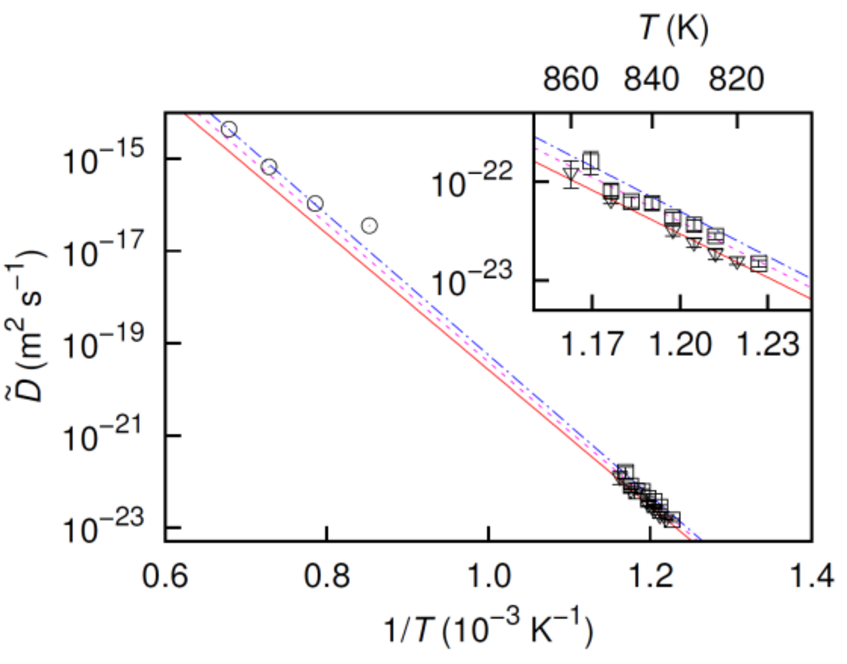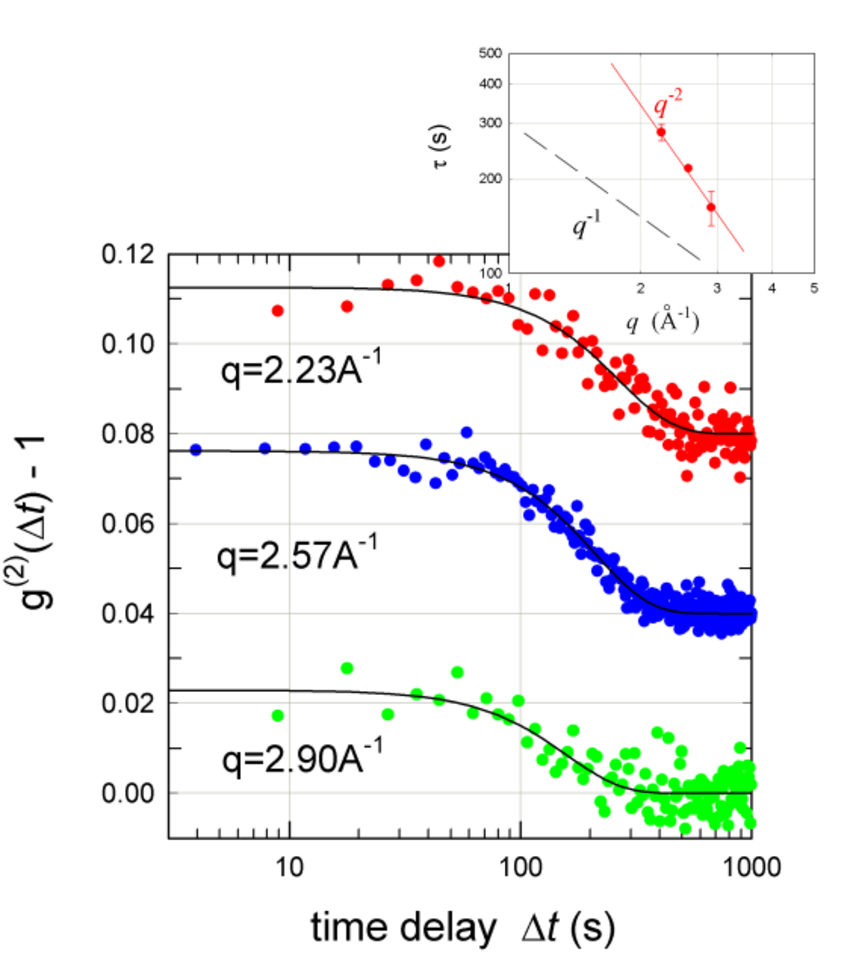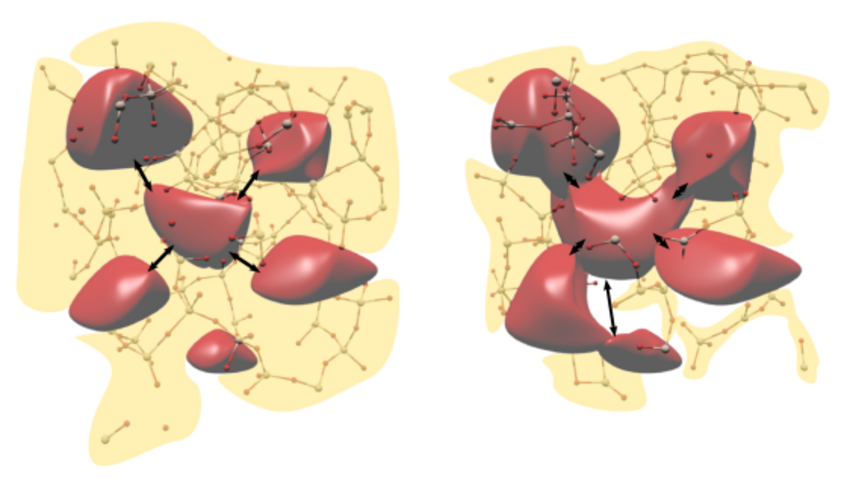Atomare Diffusion untersucht mit kohärenter Röntgenstrahlung

Atomare Diffusion untersucht mit kohärenter Röntgenstrahlung
| FWF Projektnummer | P22402-N20 |
|---|---|
| Projektleiter | ao. Univ. Prof. Dr. Bogdan Sepiol |
| Laufzeit | 1.11.2010–31.10.2014 |
Abstract
Understanding atomic motion in solids is a fundamental issue in synthesis and stability of technically important materials; this is even more critical in nanomaterials. The timescale of atomic motion is usually uncomfortably long for experimental techniques that rely on high energy resolution (e.g. inelastic neutron scattering or Mößbauer spectroscopy), forcing measurements at unduly high temperatures. Moreover, only a small number of selected isotopes are accessible to these methods. There exists, of course, plenty of information about atomic diffusion from tracer measurements. However, drawing conclusions from tracer measurements on the actual microscopic dynamics is a highly indirect procedure, often contradictory, and always based on assumptions. Hence, a nonresonant method not restricted to certain isotopes and capable of detecting slow diffusion is extremely desirable.
We have shown in our previous project the answer to these requirements: X-ray photon correlation spectroscopy (XPCS). This method monitors the temporal variations of the coherently scattered intensity as a function of the wavevector, that is, it measures dynamics directly in the Fourier domain. It has been applied since the emergence of high-energy synchrotron sources in the mid-90s for studies of slow dynamics on the nanometer scale, but had never been practiced before on single atoms. We have taken XPCS to its limits in terms of resolution by using it to reveal the slow atomic dynamics in a copper-gold alloy. The project at hand follows up on this success and establishes XPCS as the preferred method for studying atomic dynamics. Specifically, we have studied technically important high-temperature structural materials like Ni-Pt alloys, metallic glasses, and oxide glasses. These studies give a direct microscopic picture of the mechanisms leading to atomic transport, which can be very intricate in the case of ordered alloys. They also yield the temperature dependence of diffusion (i.e. the activation energy) in the low-temperature region.
In our project we profit from the continually increasing brilliance of existing synchrotron sources (cp. imminent upgrade of the ESRF in Grenoble) and from emerging new sources like PETRA III and the European XFEL in Hamburg.
Results
Ni–Pt alloys

Figure 1: as published in M. Stana, M. Leitner, M. Ross and B. Sepiol J. Phys.: Condens. Matter 25 (2013) 065401.; Triangles and dashed green line: single crystalline data; squares and blue solid line: polycrystalline data; circles and dash-dotted red line: tracer measurements as published in Karunaratne M S A and Reed R C 2003 Acta Mater. 51 2905–19.
Ni–Pt alloys
After successfully demonstrating the applicability of aXPCS to study atomic-scale diffusion in a binary metallic alloy (doi:10.1038/nmat2506), the next goal was investigate a solid solution. This seemed worthwhile, as it allowed crossing of several points on our agenda of advancing aXPCS. First of all, in a solid solution impurity diffusion of the solute atoms could be studied on the atomic scale and compared with atomistic models, e.g. the encounter model as introduced by Wolff, and could be directly compared with results from relatively simple Monte Carlo simulations. Secondly, as its preparation is relatively simple, single crystalline as well as polycrystalline samples could be manufactured and comprehensively studied. Thirdly, the feasibility of aXPCS for low concentrations of solute atoms could be investigated.
As a model system we choose a binary Nickel–Platinum solid solution composed of 97at.% Ni and 3at.% Pt. As we could show in our paper the scattering contrast from 3at.% solute atoms is sufficient to apply aXPCS. We could also show that while single crystalline samples yield more information about the system, also polycrystalline samples can be used under certain conditions to study atomic-scale diffusion. This opens this technique to a variety of samples that can not be grown as single crystals. Moreover, the encounter model described the measured data very well and its application in combination with the Arrhenius theory yields results that agree very well with such from other techniques like the well established tracer technique (see Figure 1).
The results of this work were published in: M. Stana, M. Leitner, M. Ross and B. Sepiol, “Studies of atomic diffusion in Ni–Pt solid solution by x-ray photon correlation spectroscopy” J. Phys.: Condens. Matter vol. 25, no. 6 (2013) – doi: 10.1088/0953-8984/25/6/065401
Metallic glasses

Figure 2: Autocorrelation function g(2)(q, Δt) fitted via a compressed exponential function with a factor b = 1.8(1). The inset shows the q-dependence of the correlation decay time t(q), the life-time of fluctuations corresponding to the wavevector q gauges the dynamics in the sample.
Metallic glasses
Parallel to studies on crystalline phases we have undertaken feasibility tests to study amorphous matter. Metallic glasses were our first choice based on the expectation that they would behave very similar to simple model systems such as hard spheres. We measured diffusion properties of the Inoue metallic glass Zr65A7.5Ni10Cu17.5 and studied the influence of slow recrystallization on correlation times slightly below the glass temperature. It was, however, impossible to measure dynamics in a glassy state in close-to-equilibrium conditions. At temperatures below the glass temperature but high enough to be measurable by aXPCS with currently available X-ray brilliance, crystallization was already setting in, producing nanoscale, stress-related displacements. This could also be seen in the unusual, compressed shape of the autocorrelation function. Another paper on a different metallic glass (Mg65Cu25Y10) by Ruta et al. (Physical Review Letters 109, 165701 (2012)) published simultaneously yielded similar results. Concluding, it seems that the compressed autocorrelation function is universal and cannot be explained by the well-known theories for glassy dynamics, which all predict a stretched exponential shape in the liquid as well as in the glassy state. The existence of a universal dynamical behavior due to the scaling of the relaxation time to a single curve, independently of the microscopic details of the systems was suggested (Ruta et al., The Journal of Chemical Physics 138, 054508 (2013)) . It is a matter of dispute if the origin of the relaxation behavior lies in the internal stress reduction as suggested in the soft matter glassy systems, or in the crystallization process. It is our conviction that more brilliant X-ray sources than those currently available are required to settle this debate.
The results of this work were published in: M. Leitner, B. Sepiol, L.-M. Stadler, and B. Pfau, “Time-resolved study of the crystallization dynamics in a metallic glass,” Physical Review B, vol. 86, no. 6, p. 064202 (2012) – doi: 10.1103/PhysRevB.86.064202
Oxide glasses

Figure 3: Visualization of effective lead atom jumps (arrows) in lead silicate glass. The bulk-shaped structures in red represent regions of lead oxide aggregation; regions in yellow represent silica oxide structures. Left: For low lead content glass, the diffusive motion is driven by jumps between regions of lead oxide aggregation. Right: In high lead content glass, two distinct types of jump processes exist. The network connectivity allows for a short-range diffusion along network paths, however also jump processes through the voids over longer distances contribute to the diffusion.
Oxide glasses
Understanding glasses on a fundamental level has been a long-standing challenge in many scientific disciplines. Structural random network formation is an important model for explaining the glass forming ability of many materials. The dynamics of basic network components play a key role in the quest to decode the peculiar properties of this material class. We utilized the new method of atomic-scale X-ray Photon Correlation Spectroscopy (aXPCS) for studying atomic dynamics in a network-forming glass and to shed light on the processes governing these substances on a fundamental level.
The network forming capability of both basic components depending on the composition is an outstanding property of lead silicate glass. We showed that the dynamics on the atomic level below and above the alleged transition from network forming of silica oxide to lead oxide change significantly. For low lead oxide concentration, only diffusion via long range jumps was observed, while for high lead oxide concentration, the percolation of the network facilitated a large amount of additional short range jumps. This shows that aXPCS is a viable tool to study diffusion in glasses below the glass transition point.
The results of this work were published in: M. Ross et al., New Journal of Physics vol. 16, 093042 (2014) – doi: 10.1088/1367-2630/16/9/093042
With aXPCS as new tool to study atomic diffusion in amorphous systems, many new insights into basic processes in technically relevant materials, like fast ionic conductors, can be obtained.
